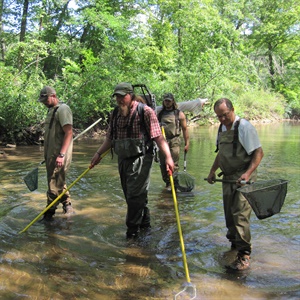The ANHC aquatic species biologist Jason Throneberry and staff from the Arkansas Department of Environmental Quality (ADEQ) recently completed water quality and biological sampling on portions of the Kings River at our Kings River Falls Natural Area and the results were all positive for good water quality.
A well-balanced and functioning biological community is one of the best indicators of a healthy stream, capable of providing vital ecosystem services. In order to test the health of the stream, a mobile water lab was deployed, taking multiple water quality measurements over a 72-hour period.
But these samples are just a snapshot of the water at that moment and can change quickly, so additional sampling was done of the organisms that were present. The biological sampling included measurements of the complex mixture of algae, cyanobacteria, heterotrophic microbes, and detritus called “periphyton” that attaches to submerged surfaces in healthy aquatic systems and absorbs contaminants.
Benthic macroinvertebrates (bottom-dwelling organisms including aquatic insects, crayfish, clams, snails, and worms) were also surveyed to determine the water quality because of their high numbers, known pollution tolerances, limited mobility, wide range of feeding habits, varied life spans, and dependence on the land environment around the stream. Their composition can be affected by either periodic episodes of poor water quality or continuous poor water quality.
Fish surveys were also done in the restoration area, using backpack and barge electrofishing. Shocking fish does not harm them when done properly – it simply stuns the fish so they are more easily netted, and all of the fish noted in these surveys were later released. In the pools of the restoration area, biologists found creek chubs and smallmouth bass (both top predators) along with sunfish and various minnows. In the riffles and runs, biologists found good water quality indicators such as slender madtoms and darters.
